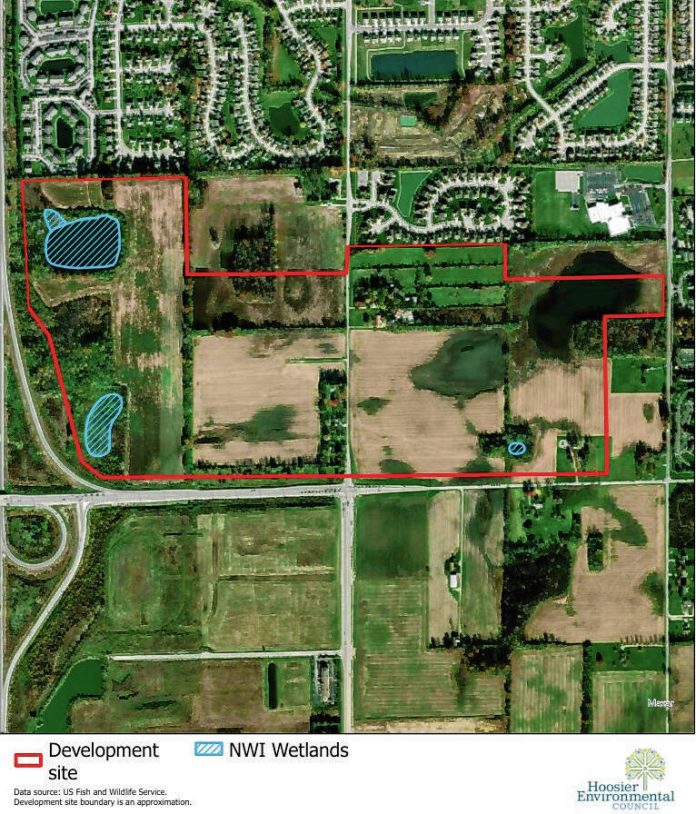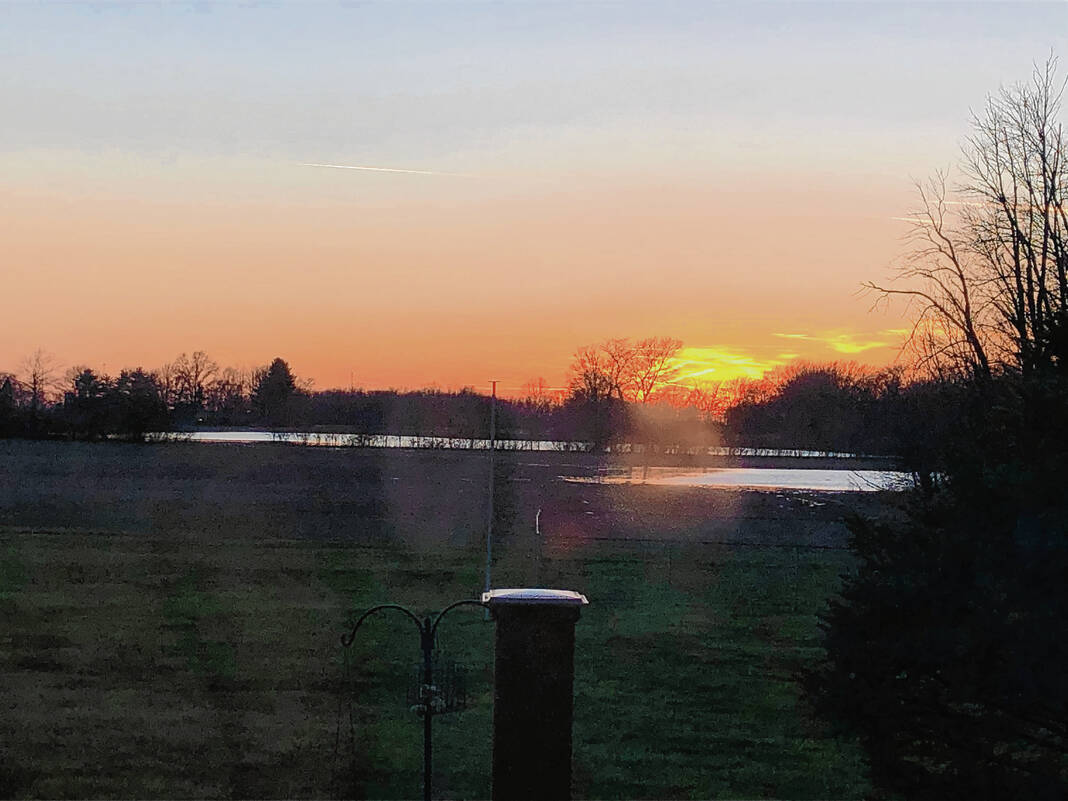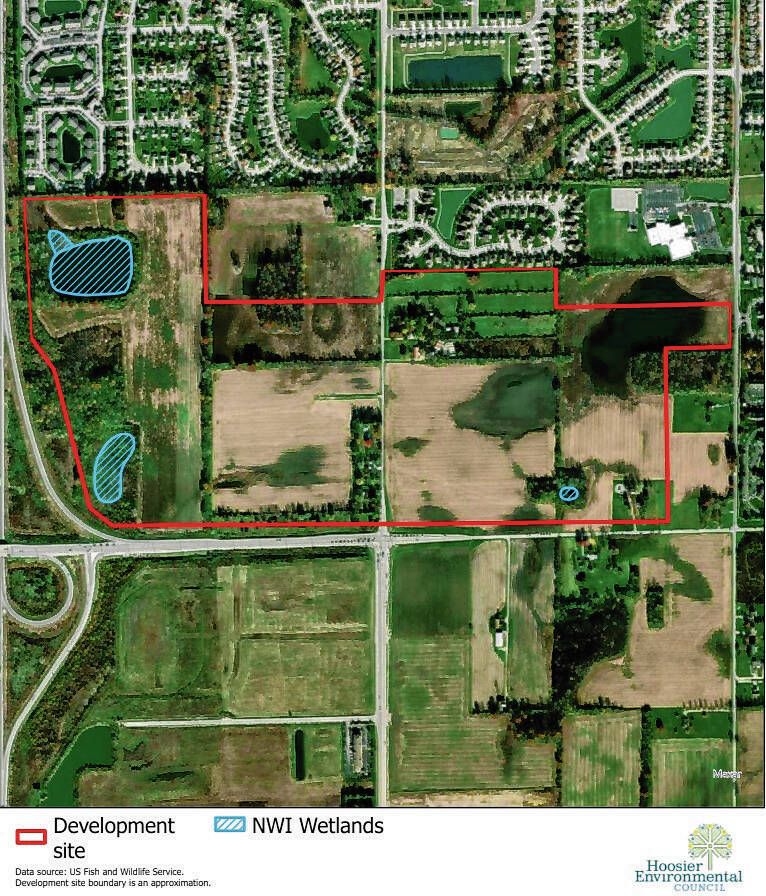Over 2,300 signed a letter requesting the Indiana Department of Environmental Management deny a permit to build a 45-acre industrial park at County Line Road and Arlington Avenue on the southside of Indianapolis. Hoosiers are concerned that the development would destroy unprotected wetlands in the area.
The Hoosier Environmental Council collected the signatures and have requested a public hearing on the matter.
Gershman Partners and Citimark are planning to build a $175 million industrial park to span the northside of County Line Road from Arlington Avenue to Interstate 65. The development is expected to have five industrial buildings totaling about two million square feet, space for restaurants and retail and 5 acres of wetland and park space, according to media reports.
The commercial and industrial warehouse will “directly impact” 28 acres of wetlands, according to HEC. The site is located within the Pleasant Run Creek watershed; the wetlands are a combination of ponds, permanent wetlands and areas that become short-term wetlands, some forested and some not.
State and federal laws stripped wetland protections in 2021 and 2023 that would have previously regulated about 20 acres of wetlands in the area.
Last year, the Supreme Court ruled in Sackett v. Environmental Protection Agency that the protections only extend to wetlands “that have a continuous surface connection with waters of the United States.” The ruling, coupled with Indiana’s Senate Enrolled Act 389, effectively stripped the protections the area would have had, said Susie McGovern, senior water policy associate for HEC.
Now, only 4 acres of the wetlands are regulated under current laws.
“This development is an example of failed state wetland policy,” McGovern said. “I think our state policy currently has an effect. We really need better action to protect wetlands and better state policy.”
The area also is a local hotspot for wildlife. It is not officially a protected area, but wildlife such as Sandhill Cranes, bald eagles, owls and more have been seen in the area, McGovern said.
“It’s been enough to have people park on the side of the road,” McGovern said.
The wetlands need to be protected because they provide a variety of functions including flood reduction, water purification and improving people’s mental health, McGovern said.
“We’d love for the wetlands to ultimately be protected and conserved. That’s not to say that an industrial development couldn’t fit with the footprint of this land because you could build one warehouse around these wetlands and there’s a kind of emerging development concept for that and it’s called conservation development.”
There is potential for conservation development around the wetlands that would protect the natural assets.
Gershman Partners officials have had conversations with HEC and nearby residents about reducing the number of impacted wetlands. Those conversations have already resulted in fewer acres of impacted wetlands and the addition of wildlife viewing amenities in the plans, said Ryan Gershman, principal at Gershman Partners.
“This development includes the preservation of significant wetland areas and will provide wildlife viewing amenities to area residents, which is the direct result of our engagement across multiple neighborhood meetings and public hearings over the last year,” the developer said in a statement. “The project also includes significant onsite and offsite infrastructure investment and stormwater upgrades. We are proud that this project will produce hundreds of high-quality jobs for Indianapolis residents with a thoughtful site plan that is in full compliance with local, state and federal requirements.”
Wetland loss is a problem state-wide, HEC officials said. Indiana has lost about 85% of wetlands in the last two centuries, according to data by the Indiana Department of Natural Resources.
The loss of wetlands could lead to more flooding as flood storage capacity is diminished and the loss of the few remaining wetlands in the Pleasant Run Creek watershed, HEC officials said. A one-acre wetland can typically store over one million gallons of water, according to the EPA.
Removing wetlands places more pressure and demand on a stream system and can create problematic flooding, McGovern said.
“The wetlands are kind of naturally reestablishing themselves and capturing all this flood water,” McGovern said. “I know people are concerned about the potential impacts of, if they build over these wetlands, where’s the water gonna go? Now what is the flooding gonna be like in the future?”
In 2022, the Indiana Wetland Task Force found in a report that the loss of wetlands has “a measurable negative impact on residents, particularly from a water quality and flooding standpoint.”








